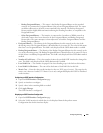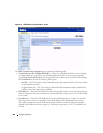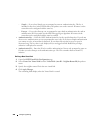
Configuring Routing 485
•
LS ID
— The Link State ID identifies the piece of the routing domain that is being described by the
advertisement. The value of the LS ID depends on the advertisement's LS type.
•
Age
— The time since the link state advertisement was first originated, in seconds.
•
Sequence
— The sequence number field is a signed 32-bit integer. It is used to detect old and
duplicate link state advertisements. The larger the sequence number, the more recent the
advertisement.
•
Checksum
— The checksum is used to detect data corruption of an advertisement. This corruption
can occur while an advertisement is being flooded, or while it is being held in a router's memory. This
field is the checksum of the complete contents of the advertisement, except the LS age field.
•
Options
— The Options field in the link state advertisement header indicates which optional
capabilities are associated with the advertisement. Possible values are:
–
Q
— This enables support for QoS Traffic Engineering.
–
E
— This describes the way AS-external-LSAs are flooded.
–
MC
— This describes the way IP multicast datagrams are forwarded according to the standard
specifications.
–
O
— This describes whether Opaque-LSAs are supported.
–
V
— This describes whether OSPF++ extensions for VPN/COS are supported.
Virtual Link Configuration
Use the Virtual Link Configuration
page to create or configure virtual interface information for a
specific area and neighbor. A valid OSPF area must be configured before this page can be displayed.
To display the page, click Routing > OSPF > Virtual Link Configuration in the tree view.


















